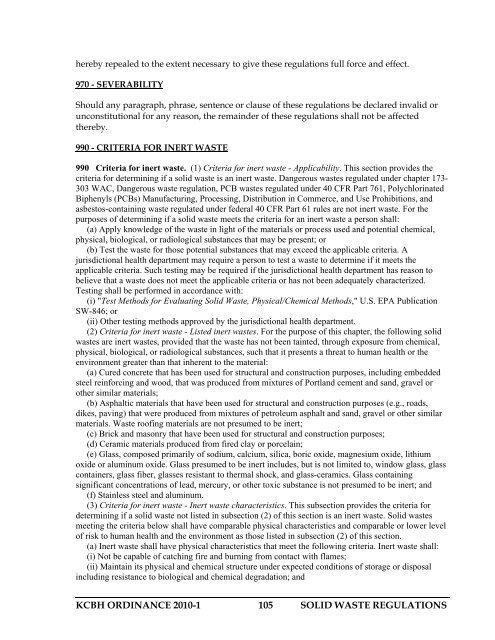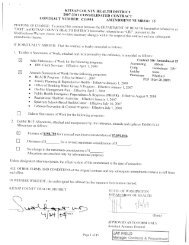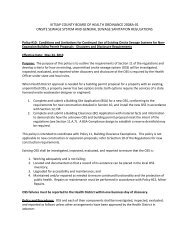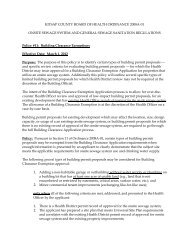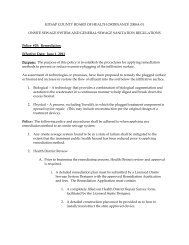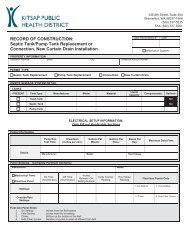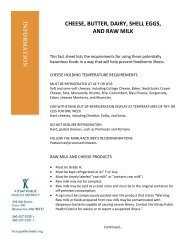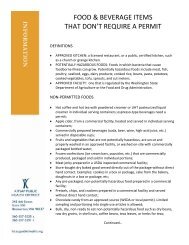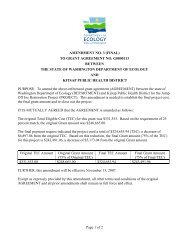SOLID WASTE REGULATIONS - Kitsap Public Health District
SOLID WASTE REGULATIONS - Kitsap Public Health District
SOLID WASTE REGULATIONS - Kitsap Public Health District
Create successful ePaper yourself
Turn your PDF publications into a flip-book with our unique Google optimized e-Paper software.
hereby repealed to the extent necessary to give these regulations full force and effect.<br />
970 - SEVERABILITY<br />
Should any paragraph, phrase, sentence or clause of these regulations be declared invalid or<br />
unconstitutional for any reason, the remainder of these regulations shall not be affected<br />
thereby.<br />
990 - CRITERIA FOR INERT <strong>WASTE</strong><br />
990 Criteria for inert waste. (1) Criteria for inert waste - Applicability. This section provides the<br />
criteria for determining if a solid waste is an inert waste. Dangerous wastes regulated under chapter 173-<br />
303 WAC, Dangerous waste regulation, PCB wastes regulated under 40 CFR Part 761, Polychlorinated<br />
Biphenyls (PCBs) Manufacturing, Processing, Distribution in Commerce, and Use Prohibitions, and<br />
asbestos-containing waste regulated under federal 40 CFR Part 61 rules are not inert waste. For the<br />
purposes of determining if a solid waste meets the criteria for an inert waste a person shall:<br />
(a) Apply knowledge of the waste in light of the materials or process used and potential chemical,<br />
physical, biological, or radiological substances that may be present; or<br />
(b) Test the waste for those potential substances that may exceed the applicable criteria. A<br />
jurisdictional health department may require a person to test a waste to determine if it meets the<br />
applicable criteria. Such testing may be required if the jurisdictional health department has reason to<br />
believe that a waste does not meet the applicable criteria or has not been adequately characterized.<br />
Testing shall be performed in accordance with:<br />
(i) "Test Methods for Evaluating Solid Waste, Physical/Chemical Methods," U.S. EPA <strong>Public</strong>ation<br />
SW-846; or<br />
(ii) Other testing methods approved by the jurisdictional health department.<br />
(2) Criteria for inert waste - Listed inert wastes. For the purpose of this chapter, the following solid<br />
wastes are inert wastes, provided that the waste has not been tainted, through exposure from chemical,<br />
physical, biological, or radiological substances, such that it presents a threat to human health or the<br />
environment greater than that inherent to the material:<br />
(a) Cured concrete that has been used for structural and construction purposes, including embedded<br />
steel reinforcing and wood, that was produced from mixtures of Portland cement and sand, gravel or<br />
other similar materials;<br />
(b) Asphaltic materials that have been used for structural and construction purposes (e.g., roads,<br />
dikes, paving) that were produced from mixtures of petroleum asphalt and sand, gravel or other similar<br />
materials. Waste roofing materials are not presumed to be inert;<br />
(c) Brick and masonry that have been used for structural and construction purposes;<br />
(d) Ceramic materials produced from fired clay or porcelain;<br />
(e) Glass, composed primarily of sodium, calcium, silica, boric oxide, magnesium oxide, lithium<br />
oxide or aluminum oxide. Glass presumed to be inert includes, but is not limited to, window glass, glass<br />
containers, glass fiber, glasses resistant to thermal shock, and glass-ceramics. Glass containing<br />
significant concentrations of lead, mercury, or other toxic substance is not presumed to be inert; and<br />
(f) Stainless steel and aluminum.<br />
(3) Criteria for inert waste - Inert waste characteristics. This subsection provides the criteria for<br />
determining if a solid waste not listed in subsection (2) of this section is an inert waste. Solid wastes<br />
meeting the criteria below shall have comparable physical characteristics and comparable or lower level<br />
of risk to human health and the environment as those listed in subsection (2) of this section.<br />
(a) Inert waste shall have physical characteristics that meet the following criteria. Inert waste shall:<br />
(i) Not be capable of catching fire and burning from contact with flames;<br />
(ii) Maintain its physical and chemical structure under expected conditions of storage or disposal<br />
including resistance to biological and chemical degradation; and<br />
KCBH ORDINANCE 2010-1 105 <strong>SOLID</strong> <strong>WASTE</strong> <strong>REGULATIONS</strong>


